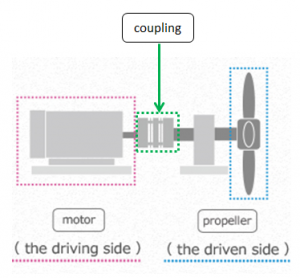Coupling: Difference between revisions
Jump to navigation
Jump to search
No edit summary |
No edit summary |
||
| Line 1: | Line 1: | ||
A coupling is a machine element that connects the shaft from a driving component, such as a motor, to the shaft of a driven component, such as a propeller, a pump, or a gearbox. | A coupling is a [[machine elements|machine element]] that connects the shaft from a driving component, such as a motor, to the shaft of a driven component, such as a propeller, a pump, or a gearbox. | ||
[[File:Coupling_context.png|300px|right]] | [[File:Coupling_context.png|300px|right]] | ||
The functions of a coupling is to: | The functions of a coupling is to: | ||
* transmit rotational motion or torque from one shaft to the other, | * transmit rotational motion or [[torque]] from one shaft to the other, | ||
* compensate for misalignment between the two shafts, | * compensate for misalignment between the two shafts, | ||
* absorb vibration from one shaft and prevent it from being transmitted to the other, | * absorb vibration from one shaft and prevent it from being transmitted to the other, | ||
Latest revision as of 19:11, 4 September 2022
A coupling is a machine element that connects the shaft from a driving component, such as a motor, to the shaft of a driven component, such as a propeller, a pump, or a gearbox.
The functions of a coupling is to:
- transmit rotational motion or torque from one shaft to the other,
- compensate for misalignment between the two shafts,
- absorb vibration from one shaft and prevent it from being transmitted to the other,
- absorb heat from one shaft and prevent it from being transmitted to the other,
- isolate electricity and prevent it from being transmitted from one shaft to the other.
